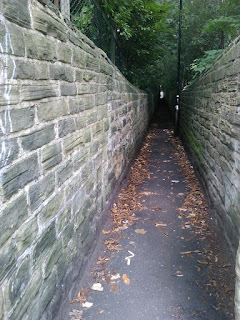The Tale of Laertes: Double Whammy.
Laertes is in his late
twenties when he enrols on the Access course. He had been allowed to leave
school at fourteen for several reasons, he doesn’t read well, he did not enjoy
the patriarchal system at school, got into trouble and became a school refuser.
Finally the school let him leave, and he went to help in his Dad’s plastering
business.
Endeavouring to acclimatise
and enculturate him into the college milieu is a difficult task as he is not
used to how to behave in an educational setting, this may be down to the bad
experience and memories of school. He is good naturedly disruptive and
constantly coming across our administrators for not conforming to ‘normal’
student protocols like arriving on time, staying the whole day and handing work
in on time.
The tale of Laertes is
that of a non-traditional route into FE, and is one we are familiar with on the
Access course. The collaborative work we do with students talking through their
educational expectations, goals and how to achieve them through study or
sometimes other means, takes time and the building of trust and relationship.
The Access course is a place to come at the beginning of an educational journey
and some students realize at the end of the first year of study that, either
art is not for them, education and its stipulations is not the right fit or it
is the wrong time of life (family commitments like looking after a suddenly
sick relative or a new baby) or a wellness issue (a personal mental or physical
health breakdown) stops them studying.
Laertes’ level of
literacy was very low because of his historical patchy attendance at school and
his refusal to sit any exams at GCSE. And yet his art practice was developing
through the course to become good. The stumbling block was the written and
critical elements of the course. As the weeks went on he became less engaged
because of the need to complete critical annotations and art history and
contextual studies sessions. In the end Laertes stopped coming to class and
eventually dropped out, taking Juno a female student with him, after they had
begun a relationship. He did not complete and by extension she did not complete
either. Double whammy.
Biesta (2014) and
Felding’s studies (2005) on Community of Inquiry show that there has to be a
meeting in the middle, the opportunity to get involved is provided but the
students who don’t engage for whatever reason, bad experience in the past and
trust issues don’t benefit from a collaborative democratisation of the classroom
(Broadhead and Gregson 2017). Or is it that the seed has been sown? Ideas and
new experiences of positive educational understandings mean that students like
Laertes may try again. Access students who drop out mid-term will very often
return next academic year to complete the qualification.
Bibliography
Biesta, G. J. J., (2014) The Beautiful Risk of Education, Oxon,
Paradigm Books, Routledge.
Broadhead,
S and Gregson, M (2017) Practical Wisdom
and Democratic Education, Phronesis, Art and Non Traditional Students, London,
Palgrave Macmillan.
Fielding, M. et al (2005)
Factors influencing the transfer of good
practice, London: DfES, Research Brief No RB615.
http://www.et-foundation.co.uk/research/joint-practice-development/




Comments
Post a Comment